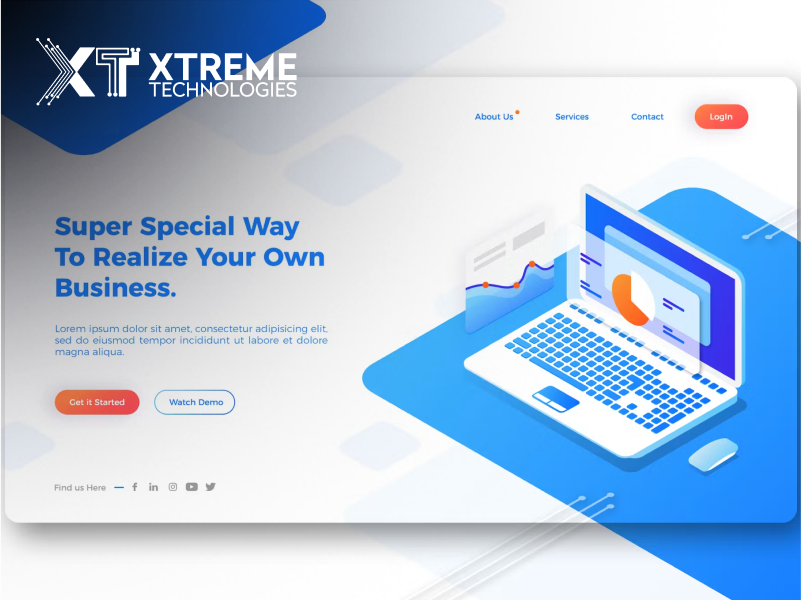
Ecommerce Website Design – Top 11 Tips to Make Your Site Amazing
Published on: June 14, 2023
Ecommerce is a vast business; no one kills a sale quicker than a website that looks unprofessional. Customers must trust your site enough to give their personal and payment information.
To do that, you must create a shopping experience as close to an in-person shop as possible.
Ecommerce websites have a lot of content to process for visitors, and adding more information can overwhelm them. A clutter-free design allows them to find what they’re looking for quickly and makes the checkout experience as seamless as possible.
 Notebook Therapy features user-generated photos on its homepage to promote authenticity. Social proof can help boost conversions by increasing the perceived value of your products or services. Make sure to display the privacy policies for your target audience’s region. Xtreme Technologies is one company that does this effectively, with links to their policy in the footer of every page.
Notebook Therapy features user-generated photos on its homepage to promote authenticity. Social proof can help boost conversions by increasing the perceived value of your products or services. Make sure to display the privacy policies for your target audience’s region. Xtreme Technologies is one company that does this effectively, with links to their policy in the footer of every page.
-
Use color to your advantage
If you want your ecommerce website to succeed, it's crucial to understand how color can influence a customer. For example, blue can inspire trust and confidence, while red can invoke a sense of urgency.
 Use this knowledge to your advantage when designing your ecommerce site. By incorporating color strategically, you can create an engaging experience that will lead to more conversions.
Use this knowledge to your advantage when designing your ecommerce site. By incorporating color strategically, you can create an engaging experience that will lead to more conversions.
-
Make your content scannable
You may have spent days crafting a long and detailed description for the products in your online store, but if customers can’t easily find the information they need to decide, they’ll leave and buy from another website.
 Scanners are looking for key takeaways, so use clear and concise subheads to convey the main points of each section of text. Also, use bullets and numbered lists to break up blocks of text into more manageable chunks for scanning. Finally, incorporate lots of whitespace into your pages to help them look less intimidating and more organized for readers. This will also allow them to read more quickly. These small details will help to keep your customers engaged and on your site. This is one of the most critical steps to converting them into paying customers.
Many things can go into designing an ecommerce website, but it’s important to remember that the main goal is to create a pleasant shopping experience for your customers. Adding too many bells and whistles can be overwhelming, and they may just abandon your site altogether.
In addition, simple navigation is essential to ensuring that your products are easy to find and that all the information they need is always at their fingertips. This can include a straightforward header navigation menu, on-site search features, and product filters.
Scanners are looking for key takeaways, so use clear and concise subheads to convey the main points of each section of text. Also, use bullets and numbered lists to break up blocks of text into more manageable chunks for scanning. Finally, incorporate lots of whitespace into your pages to help them look less intimidating and more organized for readers. This will also allow them to read more quickly. These small details will help to keep your customers engaged and on your site. This is one of the most critical steps to converting them into paying customers.
Many things can go into designing an ecommerce website, but it’s important to remember that the main goal is to create a pleasant shopping experience for your customers. Adding too many bells and whistles can be overwhelming, and they may just abandon your site altogether.
In addition, simple navigation is essential to ensuring that your products are easy to find and that all the information they need is always at their fingertips. This can include a straightforward header navigation menu, on-site search features, and product filters.
-
Use high-quality product photography
Product photography is the most critical factor in ecommerce sales conversion. After all, without the ability to touch, hold or smell the product, shoppers have only your images to rely on. The higher quality of your product photos, the more confidence shoppers will have in purchasing.
Great product photos catch shoppers’ attention, show what the product looks like in real life, and highlight its best features, increasing conversions and reducing returns. A quarter of all returns happen because the actual product doesn’t match the customer’s expectations based on the product photo.
Since mobile devices have surpassed desktops as the most popular way to surf the web, your ecommerce site must be fully optimized for mobile. If not, you risk losing customers to your competition.
Mobile visitors expect crystal-clear product images and fast load times. Avoid distracting them with a long product description, unnecessary graphics, or text that can increase page load time and cause users to abandon your site.
-
Accept as many payment methods as possible
When designing an ecommerce website, it is important to accept as many payment methods as possible. This is because one of the most common reasons for cart abandonment is that the customer’s preferred payment method is unavailable.
Offering multiple payment options can help reduce this problem and increase conversions. In addition, it can also help you expand into new markets. Adding these features to your website can make your customers feel valued and improve their shopping experience. This will ultimately lead to increased sales and revenue. In addition, it will give your customers peace of mind that their information is secure. This is particularly important for ecommerce websites that sell high-value goods or services.
The good news is that you no longer need to be a coding expert to create a helpful ecommerce website. Today, many ecommerce platforms take care of your technical details.
However, it’s still important to remember best practices when designing your online store. For example, storing customer data on your servers can be risky in case of a hacker attack. It’s usually better to use a third party payment gateway that lets you save your customers’ data while reducing your cybersecurity risks.
Ecommerce is a fast-growing industry with enormous potential for business owners. It’s essential to make sure your online store is optimized for user experience (UX). This will help you attract more consumers and sell more products.
To improve your ecommerce site’s navigation, group your products into categories that make sense and include a search box in familiar locations. Also, consider adding a “testimonials” page. Seeing a slew of positive reviews from real customers does wonders for building trust.
People are less likely to buy your products if they have to click through multiple pages or are overwhelmed with information. Keep the navigation layers to a minimum and avoid adding intermediary category pages.
High-quality images build trust, so have a clear way for customers to zoom in on their product of interest. Also, display testimonials and customer photos to boost shoppers' confidence before making a purchase.
Nothing kills a sale faster than a clunky checkout process. If you’re displaying a shopping cart, ensure it’s easy to find and includes all relevant information about shipping costs and payment methods.
Including customer reviews and testimonials is another way to show shoppers that your company is trustworthy. This can boost conversions and encourage new customers to make a purchase. You can hire ecommerce web development services to get the best guidance for the development of your site.
Conclusion
Nothing kills a sale quicker than an awkward product page. If visitors have to click around ten special menus before finding the product they’re looking for, they’ll hightail it out of there and snap right over to a competitor’s site.
When it comes to ecommerce, simplicity is vital. The more bells and whistles you add to your site, the more it distracts from the main goal: closing a sale.
FAQs
Q1) Why is ecommerce website design important for my online business?
Ecommerce website design plays a crucial role in the success of your online business. A well-designed website can enhance user experience, build trust, and increase conversion rates. It helps create a visually appealing and user-friendly platform that seamlessly guides visitors through the purchasing process.
Q2) How can I make my ecommerce website visually appealing?
To make your ecommerce website visually appealing, focus on clean and modern design elements. Use high-quality product images, attractive colors, and consistent branding throughout your site. Pay attention to typography and ensure easy readability. Additionally, incorporate white space to create a balanced and uncluttered layout.
Q3) What are some tips for improving website navigation?
To improve website navigation, keep your menu structure simple and intuitive. Use descriptive and concise labels for navigation links. Implement a search bar prominently to help users find specific products quickly. Include breadcrumbs to show users their current location within the site. Lastly, ensure that your navigation is mobile-friendly for users on smartphones and tablets.
Q4) How can I optimize my website for better load times?
To optimize your website for faster load times, minimize file sizes by compressing images and using efficient coding practices. Enable browser caching to reduce the need for repeat downloads. Utilize content delivery networks (CDNs) to distribute your website's files across multiple servers worldwide, improving load times for users in different locations.
Tags In
Abdullah Haroon
Abdullah is COO of Xtreme Technologies. He is Interested about Business, and Technology.

 Notebook Therapy features user-generated photos on its homepage to promote authenticity. Social proof can help boost conversions by increasing the perceived value of your products or services. Make sure to display the privacy policies for your target audience’s region. Xtreme Technologies is one company that does this effectively, with links to their policy in the footer of every page.
Notebook Therapy features user-generated photos on its homepage to promote authenticity. Social proof can help boost conversions by increasing the perceived value of your products or services. Make sure to display the privacy policies for your target audience’s region. Xtreme Technologies is one company that does this effectively, with links to their policy in the footer of every page.
 Use this knowledge to your advantage when designing your ecommerce site. By incorporating color strategically, you can create an engaging experience that will lead to more conversions.
Use this knowledge to your advantage when designing your ecommerce site. By incorporating color strategically, you can create an engaging experience that will lead to more conversions.
 Scanners are looking for key takeaways, so use clear and concise subheads to convey the main points of each section of text. Also, use bullets and numbered lists to break up blocks of text into more manageable chunks for scanning. Finally, incorporate lots of whitespace into your pages to help them look less intimidating and more organized for readers. This will also allow them to read more quickly. These small details will help to keep your customers engaged and on your site. This is one of the most critical steps to converting them into paying customers.
Scanners are looking for key takeaways, so use clear and concise subheads to convey the main points of each section of text. Also, use bullets and numbered lists to break up blocks of text into more manageable chunks for scanning. Finally, incorporate lots of whitespace into your pages to help them look less intimidating and more organized for readers. This will also allow them to read more quickly. These small details will help to keep your customers engaged and on your site. This is one of the most critical steps to converting them into paying customers.






Recent Comments